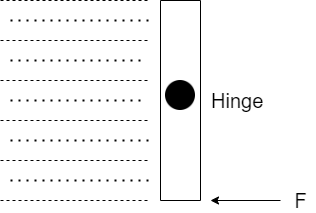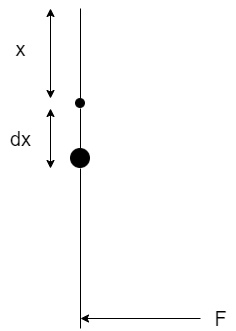Question
Question: A square gate of size \(1m \times 1m\) is hinged at its mid point A fluid of density \(\rho \) fills...
A square gate of size 1m×1m is hinged at its mid point A fluid of density ρ fills the space to the left of the gate, the force F required to hold the stationary gate is

A.3ρg
B.21ρg
C.6ρg
D.None of these
Solution
Recall the concept of force and torque. Force is defined as a push or a pull when an object interacts with another. A force can change the velocity or position of a body. While torque is the minimum force required to rotate the object and keep it in an angular motion.
Complete answer:
Step I:
The pressure at the bottom of the fluid will be more than at the top. Therefore the gate has a tendency to move from the bottom. To balance this, an extra force F is applied at the bottom. So consider a small element dx on which the pressure is exerted. Let the element dx be taken at a depth x.

Step II:
The pressure exerted by the fluid is given by ρgh
When the system is in equilibrium, the net torque acting on the hinge is zero. That is
⇒τnet=0
Step III:
The force acting on the element dx of the gate will be
⇒force=pressure×area
Pressure=ρgx
Area=1.dx
Therefore,
⇒dF=ρgx.dx
Step IV:
The torque is the minimum force required to rotate the hinge and is obtained by the product of the force and the perpendicular distance. Also the hinge is at half distance from the whole length of the gate. So the perpendicular distance will be x−0.5. So the torque about the hinge is given by
⇒dτ=∫dF.(x−0.5)
⇒0∫τdτ=0∫1ρgx.dx.(x−0.5)
⇒[τ]0τ=ρg0∫1(x2−0.5x)dx
⇒(τ−0)=ρg[3x3−20.5x2]01
⇒τ=ρg[(31−0)−(20.5−0)]
⇒τ=ρg(31−41)
⇒τ=12ρg
Step V:
The net torque applied in clockwise direction is given byF(0.5). This is because torque is the force applied in the perpendicular direction. The force applied is Fand the perpendicular distance is half of the length of the gate. The length of gate is 1m, so the perpendicular distance is 0.5m
Equating two torques,
⇒F(0.5)=12ρg
⇒105F=12ρg
⇒2F=12ρg
⇒F=6ρg
Step VI:
The force required to hold the stationary gate is 6ρg
Therefore Option C is the right answer.
Note:
It is to be noted that the torque is a vector quantity and has both magnitude and direction. The amount of torque decreases as the distance increases from the point of rotation. The direction of torque varies with the direction of force applied.
